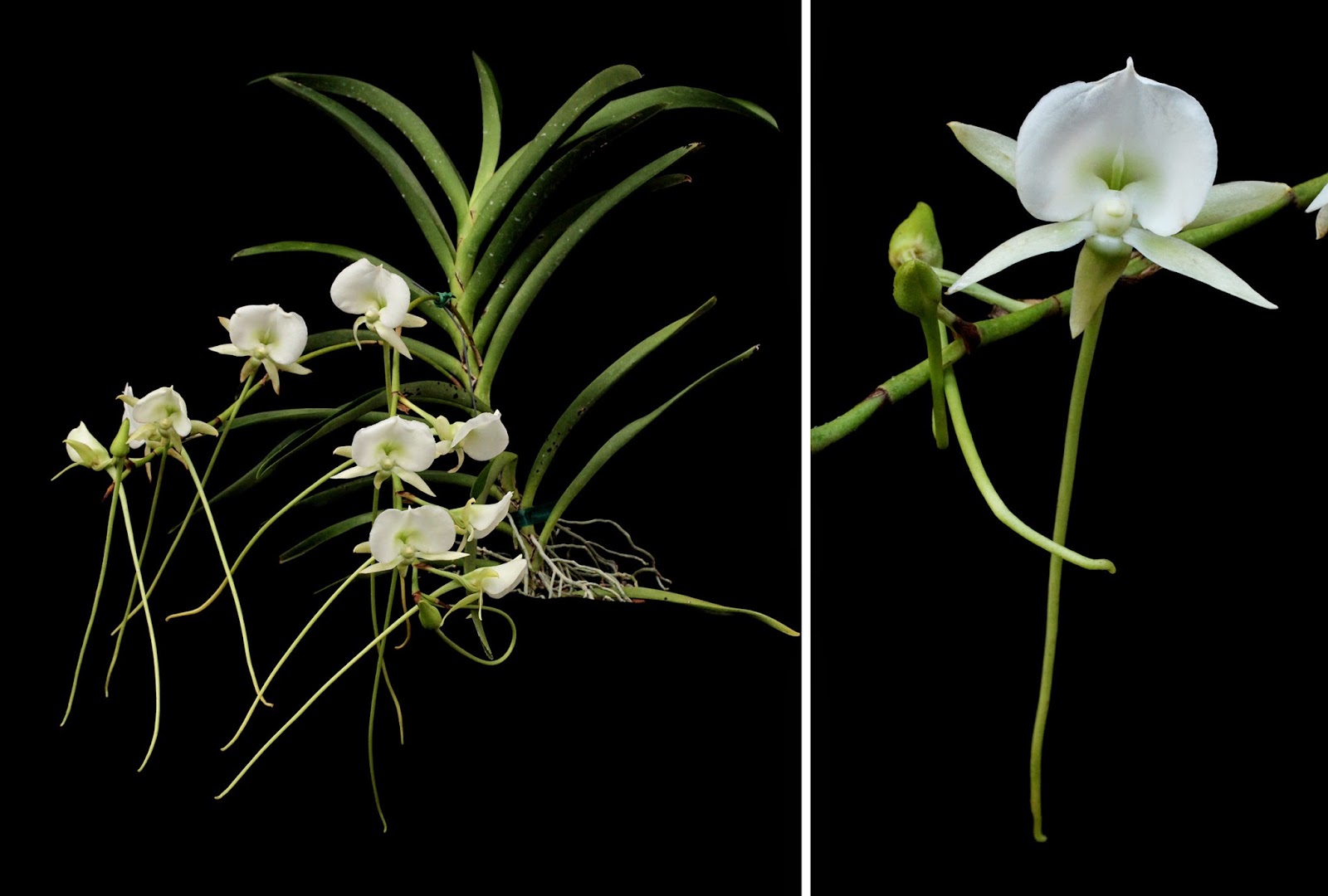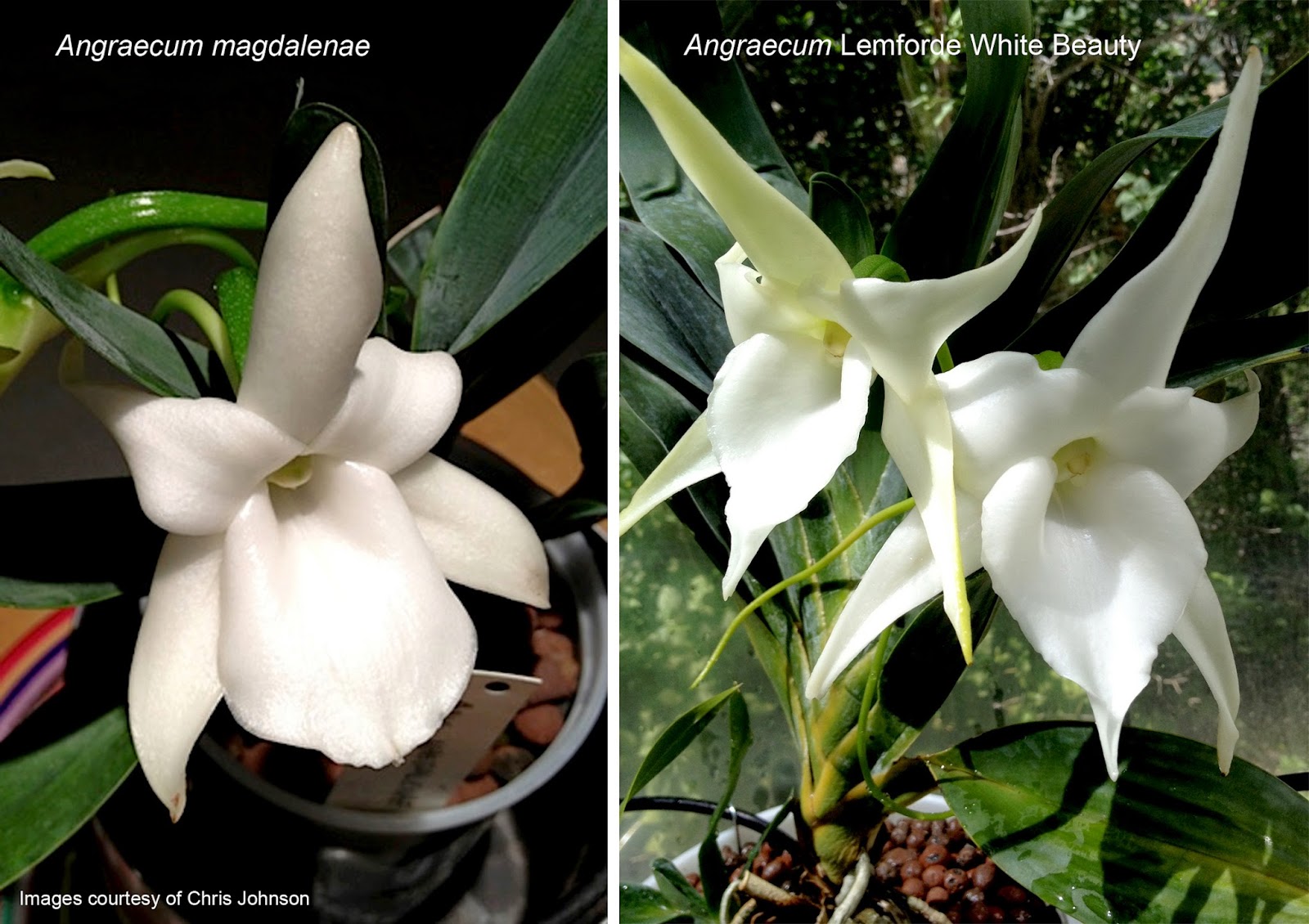One of the amazing things about being an orchid hobbyist is watching the various plants blooming for the first time. I personally will have up to a half a dozen of the same plant in various types of culture. I will pot in clay and in baskets using different mediums and mount the plants to a selection of materials; keeping records of the growth stages and eventually photographing the first blooms that appear. I am often asked about the size of a plant before it blooms for the first time. That answer varies depending upon the genera and species of the individual plant. This post will show what I have experienced in the last six months with some of the Angraecoids that are in my collection.
 Neobathiea perrieri, the flower is about 2 inches (5.1cm) high, 1.5 inches (3.9cm) wide and the nectary is 4 inches (10cm) long; the plant is mounted to a small cube of cork that is about 2.5 - 2.75 at its widest. The plant itself is compact and barely reaches 2 inches (5cm) high with leaves that can be 4 inches (10cm) long. Watered every morning and late afternoon when temperatures are above the low eighties (27 degrees C); light is now stronger than 1,500 fc and air movement is steady.
Neobathiea perrieri, the flower is about 2 inches (5.1cm) high, 1.5 inches (3.9cm) wide and the nectary is 4 inches (10cm) long; the plant is mounted to a small cube of cork that is about 2.5 - 2.75 at its widest. The plant itself is compact and barely reaches 2 inches (5cm) high with leaves that can be 4 inches (10cm) long. Watered every morning and late afternoon when temperatures are above the low eighties (27 degrees C); light is now stronger than 1,500 fc and air movement is steady.
 Angraecum Longiscott is the Angraecoid that started it all. My first bloomed in the summer 0f 2000. The above plant is one from a batch I obtained from H & R Orchids about two years ago. This plant is nearly 15 inches (38.2cm) tall with the stem reaching 9 inches (23cm) long. The leaves are 8 - 10 inches (20.5-25.5cm) long. Average flower width is 2.5 inches (6.3cm), the vertical measurement is 4.75 inches (7cm), the nectary is 8 inches (20.2cm). The above plant is potted in a 6 inch (15cm) clay pot with a medium to coarse coconut husk material; it is watered every other morning when temps are above the low eighties (28 degrees C) and every third to fourth day when below 80 degrees F (26.5 degrees C) and receives direct sunlight until about 12pm and then the light level drops to about 2,500 fc for the remainder of the day. As long as the flowers are protected from the elements, they can last 5 - 6 weeks. FRAGRANT!
Angraecum Longiscott is the Angraecoid that started it all. My first bloomed in the summer 0f 2000. The above plant is one from a batch I obtained from H & R Orchids about two years ago. This plant is nearly 15 inches (38.2cm) tall with the stem reaching 9 inches (23cm) long. The leaves are 8 - 10 inches (20.5-25.5cm) long. Average flower width is 2.5 inches (6.3cm), the vertical measurement is 4.75 inches (7cm), the nectary is 8 inches (20.2cm). The above plant is potted in a 6 inch (15cm) clay pot with a medium to coarse coconut husk material; it is watered every other morning when temps are above the low eighties (28 degrees C) and every third to fourth day when below 80 degrees F (26.5 degrees C) and receives direct sunlight until about 12pm and then the light level drops to about 2,500 fc for the remainder of the day. As long as the flowers are protected from the elements, they can last 5 - 6 weeks. FRAGRANT!
 Aerangis mystacidii, the image on the left is just now starting to bloom. It is a plant that was a part of a group I obtained two years ago. The image on the right is that of a plant that bloomed a year ago for the first time. Although they were from the same group of seedlings, the first blooming of each plant was a year apart. Each are mounted to a cork slab that is 5 x 3 inches (15x7.6x3cm) in size. These plants are watered daily and when temperatures are 85 degrees F (29.5 degrees C) or above will get watered in mid to late afternoon. They receive about 1,200 - 1,500 fc. These blooms will last about 10 - 14 days.
Aerangis mystacidii, the image on the left is just now starting to bloom. It is a plant that was a part of a group I obtained two years ago. The image on the right is that of a plant that bloomed a year ago for the first time. Although they were from the same group of seedlings, the first blooming of each plant was a year apart. Each are mounted to a cork slab that is 5 x 3 inches (15x7.6x3cm) in size. These plants are watered daily and when temperatures are 85 degrees F (29.5 degrees C) or above will get watered in mid to late afternoon. They receive about 1,200 - 1,500 fc. These blooms will last about 10 - 14 days.
 Neobathiea perrieri, the flower is about 2 inches (5.1cm) high, 1.5 inches (3.9cm) wide and the nectary is 4 inches (10cm) long; the plant is mounted to a small cube of cork that is about 2.5 - 2.75 at its widest. The plant itself is compact and barely reaches 2 inches (5cm) high with leaves that can be 4 inches (10cm) long. Watered every morning and late afternoon when temperatures are above the low eighties (27 degrees C); light is now stronger than 1,500 fc and air movement is steady.
Neobathiea perrieri, the flower is about 2 inches (5.1cm) high, 1.5 inches (3.9cm) wide and the nectary is 4 inches (10cm) long; the plant is mounted to a small cube of cork that is about 2.5 - 2.75 at its widest. The plant itself is compact and barely reaches 2 inches (5cm) high with leaves that can be 4 inches (10cm) long. Watered every morning and late afternoon when temperatures are above the low eighties (27 degrees C); light is now stronger than 1,500 fc and air movement is steady.  Angraecum Longiscott is the Angraecoid that started it all. My first bloomed in the summer 0f 2000. The above plant is one from a batch I obtained from H & R Orchids about two years ago. This plant is nearly 15 inches (38.2cm) tall with the stem reaching 9 inches (23cm) long. The leaves are 8 - 10 inches (20.5-25.5cm) long. Average flower width is 2.5 inches (6.3cm), the vertical measurement is 4.75 inches (7cm), the nectary is 8 inches (20.2cm). The above plant is potted in a 6 inch (15cm) clay pot with a medium to coarse coconut husk material; it is watered every other morning when temps are above the low eighties (28 degrees C) and every third to fourth day when below 80 degrees F (26.5 degrees C) and receives direct sunlight until about 12pm and then the light level drops to about 2,500 fc for the remainder of the day. As long as the flowers are protected from the elements, they can last 5 - 6 weeks. FRAGRANT!
Angraecum Longiscott is the Angraecoid that started it all. My first bloomed in the summer 0f 2000. The above plant is one from a batch I obtained from H & R Orchids about two years ago. This plant is nearly 15 inches (38.2cm) tall with the stem reaching 9 inches (23cm) long. The leaves are 8 - 10 inches (20.5-25.5cm) long. Average flower width is 2.5 inches (6.3cm), the vertical measurement is 4.75 inches (7cm), the nectary is 8 inches (20.2cm). The above plant is potted in a 6 inch (15cm) clay pot with a medium to coarse coconut husk material; it is watered every other morning when temps are above the low eighties (28 degrees C) and every third to fourth day when below 80 degrees F (26.5 degrees C) and receives direct sunlight until about 12pm and then the light level drops to about 2,500 fc for the remainder of the day. As long as the flowers are protected from the elements, they can last 5 - 6 weeks. FRAGRANT!  Aerangis mystacidii, the image on the left is just now starting to bloom. It is a plant that was a part of a group I obtained two years ago. The image on the right is that of a plant that bloomed a year ago for the first time. Although they were from the same group of seedlings, the first blooming of each plant was a year apart. Each are mounted to a cork slab that is 5 x 3 inches (15x7.6x3cm) in size. These plants are watered daily and when temperatures are 85 degrees F (29.5 degrees C) or above will get watered in mid to late afternoon. They receive about 1,200 - 1,500 fc. These blooms will last about 10 - 14 days.
Aerangis mystacidii, the image on the left is just now starting to bloom. It is a plant that was a part of a group I obtained two years ago. The image on the right is that of a plant that bloomed a year ago for the first time. Although they were from the same group of seedlings, the first blooming of each plant was a year apart. Each are mounted to a cork slab that is 5 x 3 inches (15x7.6x3cm) in size. These plants are watered daily and when temperatures are 85 degrees F (29.5 degrees C) or above will get watered in mid to late afternoon. They receive about 1,200 - 1,500 fc. These blooms will last about 10 - 14 days.
As more first time blooms appear, they will be added to this post.


